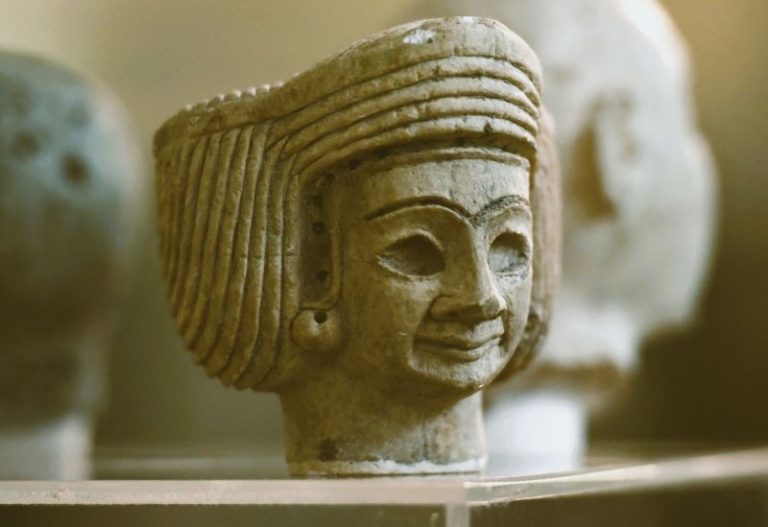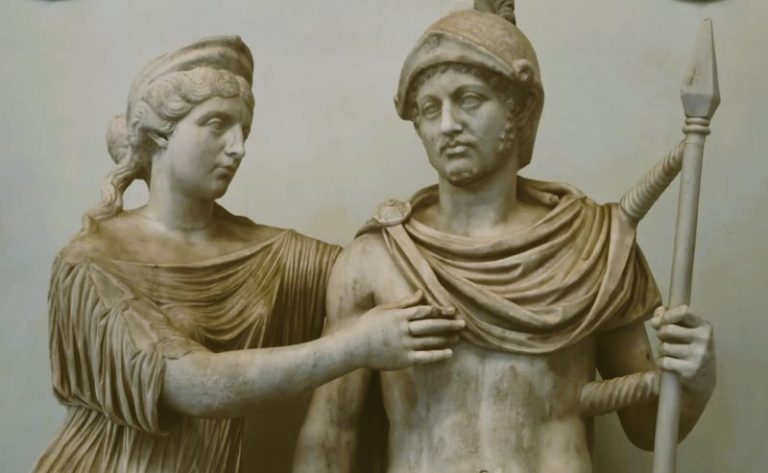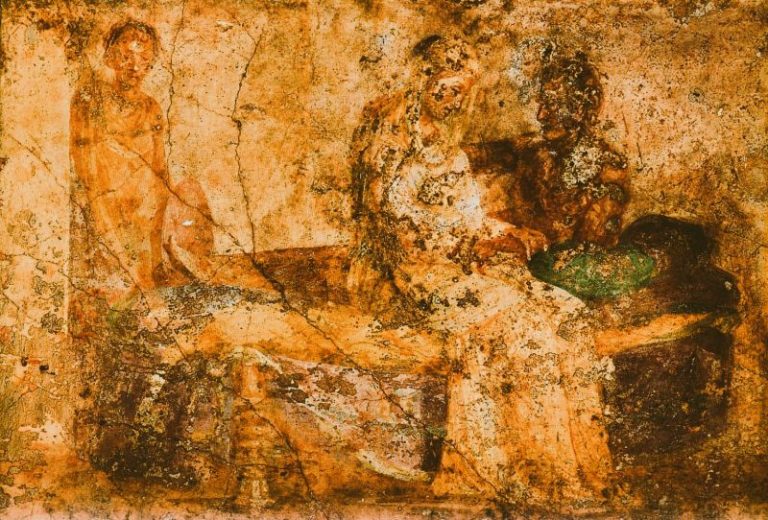
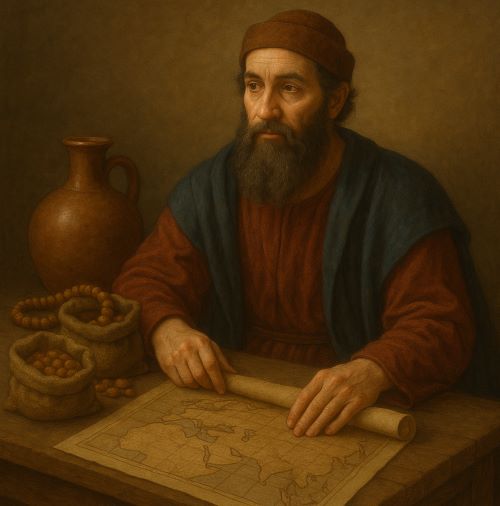
The Radhanite Jewish merchants were far more than peripheral actors in medieval history.

By Matthew A. McIntosh
Public Historian
Brewminate
Introduction
The conventional image of early medieval Europe—especially during the Carolingian period—is that of a largely isolated and insular continent, politically fragmented and economically stagnant following the fall of the Roman Empire. This picture has been increasingly challenged in recent scholarship, not least by studies of long-distance trade and cultural transmission that thrived even during periods of political decentralization. Among the most remarkable yet understudied agents of this global interconnectedness were the Radhanite Jewish merchants: an international network of traders who moved goods, information, and people across the Christian and Islamic worlds and deep into Central and East Asia. Their commercial activity between the eighth and eleventh centuries, particularly under the Carolingian Empire, reveals a more complex and globally entangled medieval economy than is often appreciated. By bridging civilizations at a time of religious division and limited imperial cohesion, the Radhanites functioned as cultural intermediaries, facilitators of commerce, and preservers of ancient trade routes that would later feed into the Renaissance and the global Age of Discovery.
Origins and Identity of the Radhanites
The primary source of information about the Radhanites comes from the ninth-century Persian geographer Ibn Khordadbeh, who describes them in his Book of Roads and Kingdoms (ca. 870 CE). He identifies them as Jewish merchants operating out of the Islamic world and traveling as far as France, Spain, India, and China.1 The etymology of their name is uncertain, but many scholars trace it to the district of Radhan near Baghdad, suggesting that they may have originated or operated prominently in Mesopotamia.2 Others speculate that the name could have derived from a place in southern France or from a Frankish trade region, tying them more directly to the Carolingian heartlands. Regardless of their exact geographic origin, they were characterized by linguistic fluency and religious adaptability, often speaking Arabic, Persian, Greek, Latin, Frankish, Slavic, and Hebrew.3
As Jews, the Radhanites occupied a unique social and religious position. They were tolerated in both Christian and Muslim lands—though not always fully accepted—and thus were able to function as neutral intermediaries in a world increasingly polarized by confessional boundaries. Their diasporic networks, religious solidarity, and shared cultural codes enabled them to maintain communication across distant territories, reinforcing a trading system that prefigured many aspects of modern global commerce.4
Trade Routes and Commodities
The Radhanites operated across an astonishingly wide geographical area. Ibn Khordadbeh records four principal overland and maritime routes they used, each connecting the Christian West to the Islamic Middle East, Central Asia, and the Far East. One route passed through the Mediterranean and North Africa, another through Constantinople and the Black Sea, and still others through Mesopotamia into Persia and India.5 They adapted flexibly to shifting political and geographic conditions, switching between sea and land routes as circumstances required.
These merchants dealt in a vast array of commodities, including:
- Silk, musk, aloes, camphor, and spices from the East
- Slaves, furs, swords, and wine from Europe and the Slavic lands
- Luxury goods such as pearls, jewelry, and incense
They also carried manuscripts, coins, and ideas, making them conduits not only of material exchange but of cultural transmission.6 Particularly important was their role in the slave trade, where they helped supply both the Islamic and Byzantine empires with European captives, often sourced from Slavic territories (giving rise to the word “slave” itself).7 While morally troubling by modern standards, this trade was a significant component of early medieval economies.
The Carolingian Context

The Carolingian Empire (c. 751–888), under rulers such as Charlemagne and Louis the Pious, oversaw a period of relative stability in Western Europe. While primarily agrarian and localized, the Carolingian economy was not isolated from broader networks. The Radhanites thrived under this regime, benefiting from its diplomatic relations with the Abbasid Caliphate and the Byzantine Empire. Charlemagne’s correspondence with Harun al-Rashid, the Abbasid caliph, reflects a conscious effort to maintain channels of contact with the Islamic world.8 In this context, the Radhanites served a vital role as neutral intermediaries able to operate across ideological divides.
Carolingian rulers appear to have recognized the strategic value of Jewish merchants. Unlike other minorities, Jews were sometimes granted special privileges in court and trade. Louis the Pious issued protections for Jewish merchants and traders in the early ninth century, reinforcing their role as useful economic agents.9 Moreover, Carolingian coinage and legal documents indicate the existence of Jewish commercial activity in cities like Narbonne and Mainz, where Radhanite merchants likely had bases of operation.10 Their ability to navigate Christian and Muslim regions made them indispensable at a time when neither Carolingian nor Islamic merchants could easily traverse hostile territories alone.
Linguistic and Cultural Competence
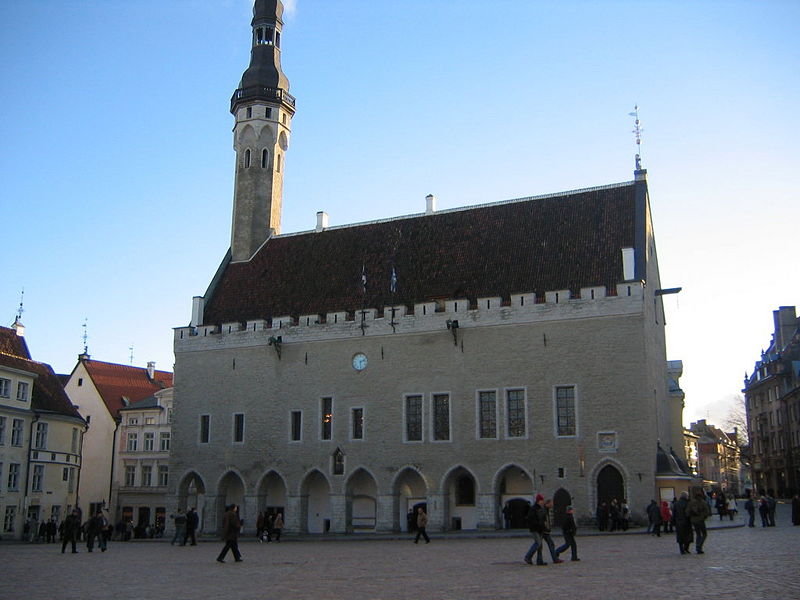
Perhaps the most remarkable aspect of the Radhanites was their linguistic and cultural fluency. Ibn Khordadbeh states that they spoke “Arabic, Persian, Roman [Greek], Frankish, Spanish, and Slavic” as well as Hebrew.11 This enabled them not only to conduct trade but also to act as interpreters, cultural liaisons, and diplomatic envoys. Their literacy—both in religious texts and commercial accounting—gave them a further advantage over many contemporary traders, who were often illiterate or limited to vernacular dialects.
This multilingualism allowed them to function in multi-ethnic markets, negotiate complex contracts, and maintain networks of trust over vast distances. It also positioned them to act as preservers and transmitters of knowledge. Some historians speculate that Radhanites may have played a role in transmitting classical Greek and Persian scientific texts to the Islamic world and, later, back to Europe during the twelfth-century translation movements.12 While definitive evidence is lacking, their place at the crossroads of civilizations makes such a role plausible.
Decline and Legacy
By the late eleventh century, the prominence of the Radhanite merchants appears to wane. Several factors contributed to this decline:
- The rise of Italian maritime republics like Venice, Genoa, and Pisa, which established their own direct trade routes to the East
- The increasing militarization of the Mediterranean following the Crusades
- The growing Islamization of Central Asia, which may have rendered Jewish networks less tolerated
- The emergence of more centralized Christian kingdoms, which often imposed stricter regulations on Jewish life
Despite their disappearance from historical sources, the Radhanites left a lasting legacy. They demonstrate the vibrancy of early medieval trade and the importance of minority groups in maintaining global economic systems. Their example challenges the notion of the “Dark Ages” as a time of isolation and shows that globalization, in a pre-modern form, was already well underway.
Conclusion
The Radhanite Jewish merchants were far more than peripheral actors in medieval history. They were cosmopolitan, adaptive, and strategically positioned to exploit the fractures and frontiers of a divided world. Under the Carolingians, they found space to operate as neutral intermediaries, connecting the Christian West with the Islamic East and beyond. Their networks prefigured many of the commercial and cultural pathways that would be fully developed in later centuries. In a world fragmented by faith and fealty, the Radhanites were bridge-builders—agents of exchange in every sense of the word.
Appendix
Endnotes
- Ibn Khordadbeh, Book of Roads and Kingdoms, trans. Guy Le Strange (Leiden: Brill, 1889), 79.
- André Wink, Al-Hind: The Making of the Indo-Islamic World, vol. 1 (Leiden: Brill, 1990), 131.
- Norman Stillman, The Jews of Arab Lands: A History and Source Book (Philadelphia: Jewish Publication Society, 1979), 27.
- S.D. Goitein, A Mediterranean Society, vol. 1 (Berkeley: University of California Press, 1967), 35.
- Ibn Khordadbeh, Book of Roads and Kingdoms, 80.
- Jonathan P. Berkey, The Formation of Islam: Religion and Society in the Near East, 600–1800 (Cambridge: Cambridge University Press, 2003), 122.
- Michael McCormick, Origins of the European Economy: Communications and Commerce, A.D. 300–900 (Cambridge: Cambridge University Press, 2001), 678.
- Rosamond McKitterick, Charlemagne: The Formation of a European Identity (Cambridge: Cambridge University Press, 2008), 192.
- Robert Chazan, European Jewry and the First Crusade (Berkeley: University of California Press, 1987), 13.
- Mark R. Cohen, Under Crescent and Cross: The Jews in the Middle Ages (Princeton: Princeton University Press, 1994), 84.
- Ibn Khordadbeh, Book of Roads and Kingdoms, 79.
- Maria Rosa Menocal, The Ornament of the World: How Muslims, Jews, and Christians Created a Culture of Tolerance in Medieval Spain (Boston: Little, Brown, 2002), 65.
Bibliography
- Berkey, Jonathan P. The Formation of Islam: Religion and Society in the Near East, 600–1800. Cambridge: Cambridge University Press, 2003.
- Chazan, Robert. European Jewry and the First Crusade. Berkeley: University of California Press, 1987.
- Cohen, Mark R. Under Crescent and Cross: The Jews in the Middle Ages. Princeton: Princeton University Press, 1994.
- Goitein, S.D. A Mediterranean Society. Vol. 1. Berkeley: University of California Press, 1967.
- Ibn Khordadbeh. Book of Roads and Kingdoms. Translated by Guy Le Strange. Leiden: Brill, 1889.
- McCormick, Michael. Origins of the European Economy: Communications and Commerce, A.D. 300–900. Cambridge: Cambridge University Press, 2001.
- McKitterick, Rosamond. Charlemagne: The Formation of a European Identity. Cambridge: Cambridge University Press, 2008.
- Menocal, Maria Rosa. The Ornament of the World: How Muslims, Jews, and Christians Created a Culture of Tolerance in Medieval Spain. Boston: Little, Brown, 2002.
- Stillman, Norman. The Jews of Arab Lands: A History and Source Book. Philadelphia: Jewish Publication Society, 1979.
- Wink, André. Al-Hind: The Making of the Indo-Islamic World. Vol. 1. Leiden: Brill, 1990.
Originally published by Brewminate, 07.01.2025, under the terms of a Creative Commons Attribution-NonCommercial-NoDerivatives 4.0 International license.
